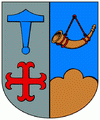Ishøj Municipality (Ishøj Kommune)
 |
The main town, and the site of the municipal council, is the town of Ishøj, which has one of Scandinavia's biggest housing projects - Vejleåparken (formerly Ishøjplanen). More than 76% of the people living there are immigrants or have immigrant parents. Consequently, Ishøj has many nicknames, for instance such as Istanhøj (a merge between the names Istanbul and Ishøj).
Neighboring municipalities are Vallensbæk to the east, Høje-Taastrup to the north and west, and Greve to the south.
Ishøj Municipality was not merged with other municipalities on 1 January 2007 as part of nationwide Kommunalreformen ("The Municipal Reform" of 2007).
Map - Ishøj Municipality (Ishøj Kommune)
Map
Country - Denmark
 |
 |
| Flag of Denmark | |
As of 2013, the Kingdom of Denmark, including the Faroe Islands and Greenland, has a total of 1,419 islands above 100 m2; 443 of which have been named and of which 78 are inhabited. Spanning a total area of 42943 km2, metropolitan Denmark consists of the northern part of the Jutland peninsula and an archipelago of 406 islands. Of these, the most populated island is Zealand, on which the capital Copenhagen is situated, followed by Funen, the North Jutlandic Island, and Amager. Denmark's geography is characterised by flat, arable land, sandy coasts, low elevation, and a temperate climate. As of 2022, it had a population of 5.928 million (1 October 2022), of which 800,000 live in the capital and largest city, Copenhagen. Denmark exercises hegemonic influence in the Danish Realm, devolving powers to handle internal affairs. Home rule was established in the Faroe Islands in 1948 and in Greenland in 1979; the latter obtained further autonomy in 2009.
Currency / Language
| ISO | Currency | Symbol | Significant figures |
|---|---|---|---|
| DKK | Danish krone | kr | 2 |
| ISO | Language |
|---|---|
| DA | Danish language |
| EN | English language |
| FO | Faroese language |
| DE | German language |















